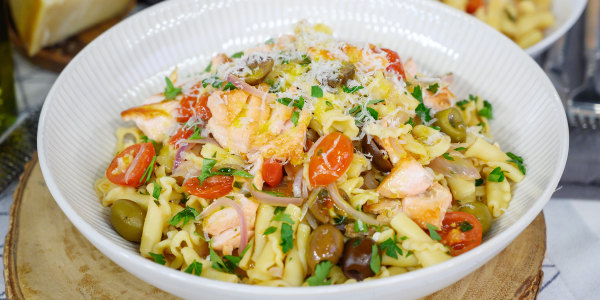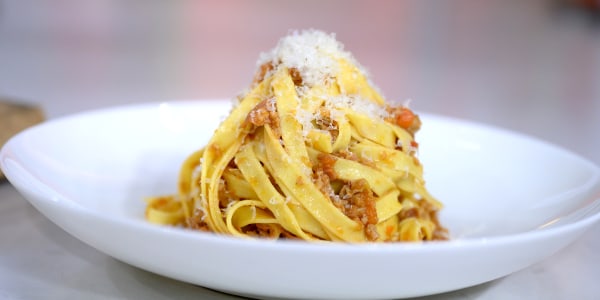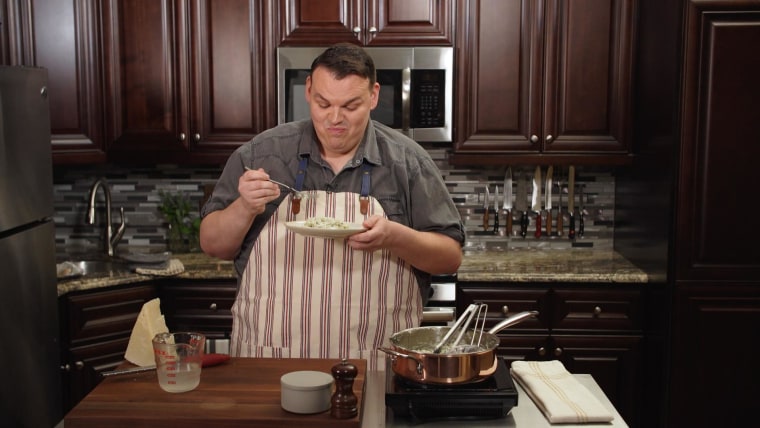When cooking pasta, you've likely noticed some recipes call for Parmigiano-Reggiano while others call for Parmesan, but what really is the difference between these two tasty cheeses?
If a creamy, dreamy fettuccine Alfredo ingredient list specifies Parmigiano-Reggiano, is it OK to dump in a cup of shelf-stable, grated Parmesan from a plastic container? Will the dish's final flavor be any different? With many of us spending more time in the kitchen than usual, rolling out our own pasta and pizzas to be topped with this Italian staple, TODAY Food turned to an expert to get some cheesy answers.
Chef Anthony Contrino, food stylist and host of TODAY digital series, "Saucy,"knows his Italian food — especially Parmigiano-Reggiano.
Trending stories,celebrity news and all the best of TODAY.
"Parmigiano-Reggiano is arguably one of the most famous cheeses in the world!" Contrino told TODAY. "True PR is produced in select provinces that lie within Italy’s food hub, Emilia Romagna."
Emilia Romagna is home to several of the world's most popular Italian foods and delicacies, from cured meats like prosciutto and mortadella to Modena's rich and sweet balsamic vinegar. Authentic Parmigiano-Reggiano can only come from this specific region. To protect its reputation against other types of Parmesan not from Emilia Romagna, Parmigiano-Reggiano's authenticity is actually protected by its own consortium, the Parmigiano Reggiano Consorzio, which ensures that every wheel of cheese produced there is stamped with a classic pin-dot mark on the rind with the words "Parmigiano-Reggiano." According to Contrino, this cheese is one of the most strictly monitored foods in the world.
Companies that print this stamp on their products without the Consorzio's authentic certification can be subject to lawsuits. Most recently, a spokesperson from the Consorzio told TODAY, the Campbell Soup Company "agreed to remove the Consorzio’s certification marks from the labels of its 'Prego' line of products," after using them on products containing the copycat Parmesan.

Nathan Congleton / TODAY
"Everything is monitored — from the feed to the color and thickness of the rind to how it can be packaged. Anything having to do with the production of the cheese takes place in this Italian 'holy land,' from the fodder that the cattle graze to the stamping (of) the cheese with its insignia," Contrino explained. "It’s this land itself that is the heart of PR’s distinct flavor and texture, and the properties of the fields where this fodder (cattle feed) is grown is unique to this region of the world. The land provides it all."
Parmigiano-Reggiano is made solely with raw cow's milk, rennet (an animal-derived enzyme used to coagulate milk in order to form a thick curd) and salt and does not require (like other Parmesans and cheeses) additives or additional bacteria.
Parmesans are the cheeses modeled after Parmigiano-Reggiano. They can be cultivated anywhere, most commonly in the U.S. and South America. Some contain different ingredients, including microbial-based enzymes, produced by live organisms like fungi, mold or yeast, in place of the rennet, cellulose powder (an anti-caking agent) or potassium sorbate (a food preservative) to keep shelf-stable, pre-grated versions fresh longer. Other, more high-end brands may have the same ingredients — but Contrino swears the taste could never match what you get from Emilia Romagna.
"Just like there are many very good sparkling wines that can’t be labeled as Champagne, you may come across some decent artisan Parmesans out there," Contrino told TODAY. "While I have come across a few of these Parmesans that have come close in flavor, they are never able to achieve the distinct granular texture that is found in Parmigiano-Reggiano."

Nathan Congleton / TODAY
To some, the appeal of pre-grated Parmesan found in the same aisle as dried pasta and sauces may be that it can be stored in the pantry. But, when bought in block form, both Parmesan and Parmigiano-Reggiano stay fresh for a really long time in the fridge. And you can stretch its shelf life even further by using the rind in stews, sauces and pasta dishes.
If it's a lower cost you're after, Contrino says there are other types of cheeses like Grana Padano or pecorino Romano crafted in other parts of Italy that don't need to meet the Consorzio's strict qualifications. These are great substitutes when you don't have Parmigiano-Reggiano but are craving its sharp, nutty flavor atop that piping bowl of pasta.
Then, all that's left to do is dig in!
"between" - Google News
May 13, 2020 at 04:16AM
https://ift.tt/2AicnmN
What's the difference between Parmesan cheese and Parmigiano-Reggiano? - Today.com
"between" - Google News
https://ift.tt/2WkNqP8
https://ift.tt/2WkjZfX
Bagikan Berita Ini

















0 Response to "What's the difference between Parmesan cheese and Parmigiano-Reggiano? - Today.com"
Post a Comment